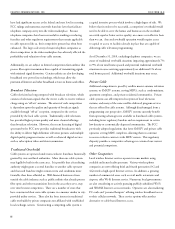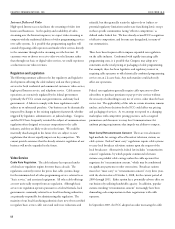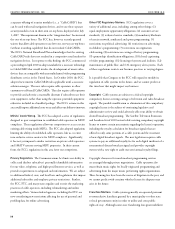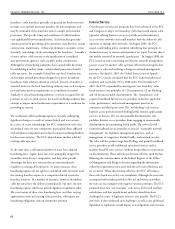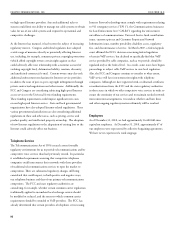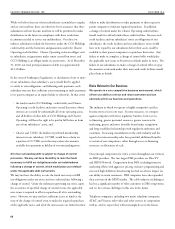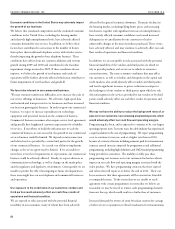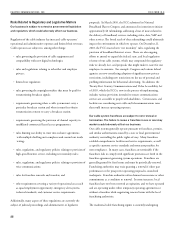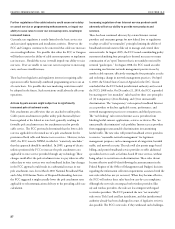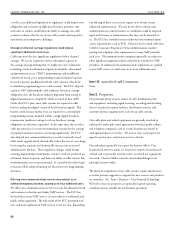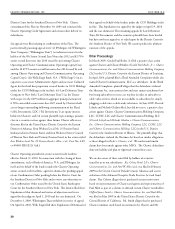Charter 2010 Annual Report Download - page 34
Download and view the complete annual report
Please find page 34 of the 2010 Charter annual report below. You can navigate through the pages in the report by either clicking on the pages listed below, or by using the keyword search tool below to find specific information within the annual report.
Economic conditions in the United States may adversely impact
the growth of our business.
We believe that continued competition and the weakened economic
conditions in the United States, including the housing market
and relatively high unemployment levels, have adversely affected
consumer demand for our services. In addition, we believe these
factors have contributed to an increase in the number of homes
that replace their traditional telephone service with wireless service
thereby impacting the growth of our telephone business. ese
conditions have affected our net customer additions and revenue
growth during 2009 and 2010 and contributed to the franchise
impairment charge incurred in 2009. If these conditions do not
improve, we believe the growth of our business and results of
operations will be further adversely affected which may contribute to
future impairments of our franchises and goodwill.
We face risks inherent in our commercial business.
We may encounter unforeseen difficulties as we increase the scale of
our service offerings to businesses. We sell video, high-speed data
and network and transport services to businesses and have increased
our focus on growing this business. In order to grow our commercial
business, we expect to increase expenditures on technology,
equipment and personnel focused on the commercial business.
Commercial business customers often require service level agreements
and generally have heightened customer expectations for reliability
of services. If our efforts to build the infrastructure to scale the
commercial business are not successful, the growth of our commercial
services business would be limited. We depend on interconnection
and related services provided by certain third parties for the growth
of our commercial business. As a result, our ability to implement
changes as the services grow may be limited. If we are unable to
meet these service level requirements or expectations, our commercial
business could be adversely affected. Finally, we expect advances in
communications technology, as well as changes in the marketplace
and the regulatory and legislative environment. Consequently, we are
unable to predict the effect that ongoing or future developments in
these areas might have on our telephone and commercial businesses
and operations.
Our exposure to the credit risks of our customers, vendors and
third parties could adversely affect our cash ow, results of
operations and nancial condition.
We are exposed to risks associated with the potential financial
instability of our customers, many of whom have been adversely
affected by the general economic downturn. Dramatic declines in
the housing market, including falling home prices and increasing
foreclosures, together with significant increases in unemployment,
have severely affected consumer confidence and caused increased
delinquencies or cancellations by our customers or lead to
unfavorable changes in the mix of products purchased. ese events
have adversely affected, and may continue to adversely affect our cash
flow, results of operations and financial condition.
In addition, we are susceptible to risks associated with the potential
financial instability of the vendors and third parties on which we
rely to provide products and services or to which we outsource
certain functions. e same economic conditions that may affect
our customers, as well as volatility and disruption in the capital and
credit markets, also could adversely affect vendors and third parties
and lead to significant increases in prices, reduction in output or
the bankruptcy of our vendors or third parties upon which we rely.
Any interruption in the services provided by our vendors or by third
parties could adversely affect our cash flow, results of operation and
financial condition.
We may not have the ability to reduce the high growth rates of, or
pass on to our customers, our increasing programming costs, which
would adversely affect our cash ow and operating margins.
Programming has been, and is expected to continue to be, our largest
operating expense item. In recent years, the cable industry has experienced
a rapid escalation in the cost of programming. We expect programming
costs to continue to increase, and at a higher rate than in 2010,
because of a variety of factors including amounts paid for retransmission
consent, annual increases imposed by programmers and additional
programming, including high definition and OnDemand programming,
being provided to customers. e inability to fully pass these
programming cost increases on to our customers has had an adverse
impact on our cash flow and operating margins associated with the
video product. We have programming contracts that have expired
and others that will expire at or before the end of 2011. ere can
be no assurance that these agreements will be renewed on favorable
or comparable terms. To the extent that we are unable to reach
agreement with certain programmers on terms that we believe are
reasonable we may be forced to remove such programming channels
from our line-up, which could result in a further loss of customers.
Increased demands by owners of some broadcast stations for carriage
of other services or payments to those broadcasters for retransmission


